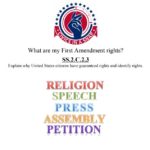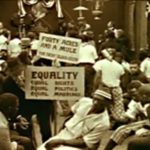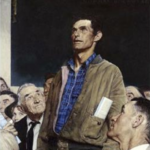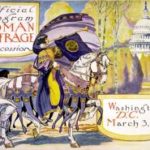Students explore the founding era legacies of assembly and petition and how those legacies informed the creation of these often-overlooked aspects of the First Amendment. They will complete a close reading activity to compare and contrast ideas presented in the Interactive Constitution and describe the ways these rights have been interpreted by the Court and used by citizens at various points throughout U.S. history. They will evaluate the constitutionality of assembly and petition rights in the modern era through an in-class, civil dialogue addressing questions about time, place, and manner restrictions; counter-protests; protests on college campuses; and other relevant assembly and petition questions.
Freedom of Assembly: The Right to Protest
This lesson will focus on freedom of assembly, as found in the First Amendment. Students will consider the importance of the right to assemble and protest by analyzing cases where First Amendment rights were in question. Using the case National Socialist Party of America v. Village of Skokie, students will consider if the government is ever allowed to control the ability to express ideas in public because viewpoints are controversial, offensive, or painful. Students will use primary sources and Supreme Court cases to consider whether the courts made the correct decision in the National Socialist Party v. Skokie case. Students will be able to form an opinion on the essential question: Is the government ever justified to restrict the freedom to assemble?
Freedom of Assembly: National Socialist Party v. Skokie
This film explores the First Amendment right of the “people peaceably to assemble” through the lens of the U.S. Supreme Court case National Socialist Party of America v. Village of Skokie. The legal fight between neo-Nazis and Holocaust survivors over a planned march in a predominantly Jewish community led to a ruling that said the neo-Nazis could not be banned from marching peacefully because of the content of their message.
Free Speech Essentials
Do your students know what they’re free to say online? At school? On a public street corner? From censorship to cyberbullying, the First Amendment and the freedoms it protects are as hotly contested as ever. This EDCollection explores 16 free speech debates ranging from the founding of our nation to recent headlines to illustrate what free speech actually means, where it comes from, and how far it can go. Whether you’re a social studies teacher looking for a complete unit or an English teacher looking to spend a single class period on free expression, there’s something for everyone. Free registration required.
Government Speech Under the First Amendment
This lesson teaches students, through a simulation related to government-sponsored Confederate monuments, about the government-speech doctrine under the First Amendment. In particular, this lesson aims to (1) introduce students to the issue of government speech; (2) teach the doctrine; (3) apply the doctrine in a contemporary context; and (4) critically analyze the doctrine.
What are my First Amendment Rights? A Lesson for Early Elementary
The Sedition Act: Certain Crimes Against the United States

The Sedition Act of 1798 passed during John Adam’s administration by the Federalist Party touched off a lively debate about the right of free speech. It also presented an early test case to the citizens and government of the United States. In times of war or imminent danger, how do you balance the need for security with the rights of individuals? How can partisan politics affect the process of shaping security policies?



